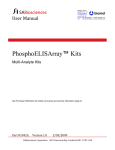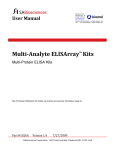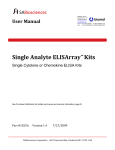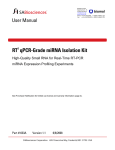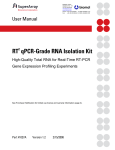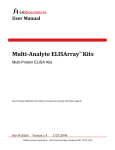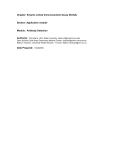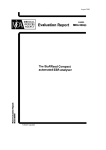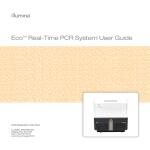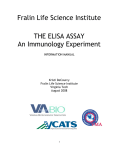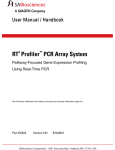Download User Manual - Biomol GmbH
Transcript
BIOMOL GmbH Waidmannstr. 35 22769 Hamburg [email protected] www.biomol.de Phone:+49-40-8532600 or 0800-2466651 (D) Fax: +49-40-85326022 or 0800-2466652 (D) User Manual PhosphoELISArray™ Kits Single Analyte Kits See Purchaser Notification for limited use license and warranty information (page 3). Part #1041A Version 1.0 03/30/2009 PhosphoELISArray Single Analyte Kits PhosphoELISArray™ Kits Single Analyte Kits User Manual (For Catalog Numbers Prefixed by FES- ######X) Ordering and Technical Service Contact Information: Tel: Fax: On-line Order: E-MAIL: BIOMOL GmbH Waidmannstr. 35 22769 Hamburg [email protected] www.biomol.de Phone:+49-40-8532600 or 0800-2466651 (D) Fax: +49-40-85326022 or 0800-2466652 (D) 1-888-503-3187 (US) 301-682-9200 (outside US) 1-888-465-9859 (US) 301-682-7300 (outside US) www.sabiosciences.com [email protected] (to place an order) [email protected] (for technical support) You may place orders by fax, e-mail or from our website. Each order should include the following information: Your contact information (name, phone, email address) Product name, catalog number and quantity Purchase order number or credit card information (Visa or MasterCard) Shipping address Billing address For more information, visit us at www.sabiosciences.com SABiosciences Corporation 6951 Executive Way Frederick, MD 21703 USA 2 CONTENTS I. Background and Introduction 4 II. Materials Provided 6 III. Precautions 6 IV. Additional Materials Required 6 V. Complementary Products 6 VI. Protocol 7 A. Reagent preparation 7 B. Cell lysate preparation 7 C. Assay Procedure 7 VII. Troubleshooting and Frequently Asked Questions 9 LIMITED PRODUCT WARRANTY This warranty limits our liability to replace this product in the event the product fails to perform due to any manufacturing defect. SABiosciences Corporation makes no other warranties of any kind, expressed or implied, including without limitation, warranties of merchantability or fitness for a particular purpose. SABiosciences Corporation shall not be liable for any direct, indirect, consequential or incidental damages arising out of the use, the results of use or the inability to use this product. NOTICE TO PURCHASER This product is intended for research purposes only and is not intended for drug or diagnostic purposes or for human use. Purchase of a PhosphoELISArray Kit does not grant rights to use or modify the kit components for resale or to use the PhosphoELISArray Kits to manufacture commercial products without written approval of SABiosciences Corporation. No other license, expressed, implied or by estoppels, is granted. U.S. patents may cover the use of certain antibodies included in the PhosphoELISArray Kit. Presently, it is not clear under U.S. laws whether commercial users must obtain licenses from the owners of the rights to these U.S. patents before using the PhosphoELISArray Kits. 3 I. Background and Introduction The PhosphoELISArray Single Analyte Kits are designed to qualitatively measure the amount of an individual protein analyte using a standard sandwich enzyme-linked immunosorbant assay (ELISA) technique. A target-specific capture antibody has been coated onto 12-well strips placed into a 96-well plate format. In addition to the pre-coated plate, the kit also includes the detection antibody, and a complete set of reagents for a colorimetric ELISA. SABiosciences’s PhosphoELISArray kits are developed with the best possible antibody pairs on the market. To develop these high-performance PhosphoELISArray kits for your research, SABiosciences screens several antibody pairs from the market, comparing them side-by-side on signal intensity, specificity, and sensitivity. Only the best possible pairs is are chosen for the PhosphoELISArray kits. Take advantage of SABiosciences assay development and optimization expertise with the Single Analyte PhosphoELISArray Kits. The PhosphoELISArray Single Analyte Kits are sandwich-based enzyme-linked immunosorbant assays. (Figure 1 displays an overview of the assay protocol.) A capture antibody specific for a single protein has been coated onto the 12-well strips. After incubation with cell lysates, the target protein is bound by the capture antibody. Following extensive washing, a detection antibody added to the wells binds the captured analyte. After washing again to remove unbound material, a HRP-linked secondary antibody is added. The wells are again washed and a colorimetric substrate solution is added, which produces a blue color in direct proportion to the amount of protein analyte present in the initial sample. The color development is stopped by adding stop solution, and the absorbance at 450 nm is measured. The magnitude of absorbence for this developed color is proportional to the quantity of bound target protein. Benefits of the Single Analyte PhosphoELISArray Kits: • High Performance: Low background. High sensitivity. Excellent linearity. • Easy to Use: No special equipment required, only the ELISA plate reader already in your lab Version 1.0 1. Prepare all reagents. Set up experimental samples and negative control. 2. Transfer 50 µl of samples into the appropriate wells of the PhosphoELISArray plate. Incubate 2 hours. 3. Wash three times. 4. Add 50 µl Detection Antibody Solution. Incubate 1 hour. 5. Wash three times. 6. Add 50 µl HRP-linked secondary antibody. Incubate 1 hour. 7. Wash four times. 8. Add 50 µl Development Solution. Incubate 20 minutes in the dark. 9. Add 50 µl Stop Solution. Read OD 450 within 30 minutes. Figure 1: Overview of the Single Analyte ELISA Kit Procedure. Total Time ~ 4.5 hours Technical Support: 888.503.3187 (US) 301.682.9200 5 PhosphoELISArray Single Analyte Kits II. Materials Provided: Component / Description Coated Plate Detection Antibody Secondary Antibody Sample dilution buffer Wash Buffer (10× Concentrate) Cell Extraction Buffer Development Solution Stop Solution Phosphatase/Protease Inhibitor Cocktail Quantity 1 plate 300 l in a 1.5-ml tube 380 l in a 1.5-ml tube 40 ml in a 60 ml bottle 80 ml in a 125 ml bottle 25 ml in a 30 ml bottle 12 ml in a 30 ml bottle 25 ml in a 60 ml bottle 250 l in a 1.5-ml tube Storage 4 °C -20 °C 4 °C or -20°C 4 °C 4 °C 4 °C 4 °C 4 °C 4 °C Storage Conditions: Reagents should be stored at 4 °C or -20°C upon receipt. Store any unused 12-well strips back into the pouch at 4 °C. Do not use kit beyond the expiration date printed on the label. Store any unused 12-well strips from an opened pouch in a zip-lock bag at 4 °C. III. Precautions 1. The Development Solution is toxic if inhaled or swallowed. Avoid contact with skin. Keep container tightly closed when not in use. 2. Stop Solution is an acidic solution. Wear eye, hand, face, and clothing protection when using this material IV. Additional Materials Required: 1. Standard ELISA Microplate Reader Capable of measuring 450-nm absorbance with a 570-nm correction wavelength 2. Wash Bottle 3. Microcentrifuge Tubes 4. Laboratory Timer V. Complementary Products: PhosphoELISArray Multi-Analyte Kits 6 Version 1.0 VI. Protocol: Please read through this entire protocol before beginning your experiment. A. Reagent Preparation: 1. All PhosphoELISArray Kit Reagents: Bring all reagents except Cell Extraction Buffer to room temperature before use. Once finished with each reagent in turn, immediately return to its proper storage conditions. 2. Wash Buffer: Dilute 50 ml of Wash Buffer Concentrate into de-ionized or distilled water (dH2O) to a final volume of 500 ml. 3. 1× Cell Extraction Buffer: Add 250 l of Phosphatase/Protease Inhibitor Cocktail to 25 ml of Cell Extraction Buffer just before using. B. Cell Lysate Preparation: 1. Aspirate media. Treat cells by adding fresh media containing regulator for desired time. 2. To harvest cells under non-denaturing conditions, remove media and rinse cells twice with ice-cold PBS. 3. Remove PBS, and add 0.5 ml ice-cold Cell Extraction Buffer with Phosphatase/Protease Inhibitor Cocktail to each culture dish (10 cm in diameter, 70-80% confluent) and incubate the plate on ice for 10 minutes with vortex at 3 minutes intervals. 4. Scrape cells off the plate and transfer to an appropriate tubes. 5. Microcentrifuge at 14,000 rpm for 10 minutes at 4 °C. 6. Aliquot the clear lysate to clean tubes. These samples are ready for the assay. Lysates are stored at -80 °C. Avoid multiple freeze/thaw cycles. C. Assay Procedure: The following recipes are designed for processing twelve of the provided 8-well strips. If processing less or more strips at the same time, scale down or up the recipes appropriately. 1. Place the required strips in the strip holder. Unused strips must be resealed and stored at 4 °C immediately. Technical Support: 888.503.3187 (US) 301.682.9200 7 PhosphoELISArray Single Analyte Kits 2. Add 50 µl of cell lysate and diluted cell lysate using sample dilution buffer into the appropriate well. Generally, lysate should make a series of 2-fold dilutions. However, dilution factors need to be titrated when specific cell lysate are used. 3. Seal with tape and press firmly onto top of microwells. Incubate the plate for 2 hours at room temperature. Alternatively, the plate can be incubated overnight at 4 °C that gives the best detection of target protein. 4. Gently remove the tape and wash wells: Decant or aspirate the contents of the wells. Wash wells by filling with 350 µl of Wash Buffer. Gently shake or tap the plate for 10 seconds to mix and follow by decanting or aspirating the solution. Blot the strips upside down on absorbent paper to remove any residual buffer. Repeat twice for a total of three washes. 5. Prepare Detection Antibody Solution Dilute 275 µl of Detection Antibody to a final volume of 5.5 ml with sample dilution buffer. 6. Add 50 µl of Detection Antibody solution to each well. Seal with tape and incubate 1 hour at room temperature. 7. Wash wells as in step 6. 8. Prepare secondary antibody If the secondary antibody is anti-rabbit IgG: Add 344 µl of the secondary antibody to a final volume of 5.5 ml with sample dilution buffer. If the secondary antibody is anti-mouse IgG: Add 5.5 µl of the secondary antibody to a final volume of 5.5 ml with sample dilution buffer. 9. Add 50 µl of secondary antibody to all wells. Incubate for 1 hour at room temperature. 10. Wash wells as in step 6, except for a total of 4 washes. 11. Add 50 µl of the Development Solution to each well. Incubate the plate for 20 minutes or longer time until the strongest staining well turns to dark blue at room temperature in the dark. 12. Add 50 µl of Stop Solution to each well. Shake gently for a few seconds. The color in the wells should change from blue to yellow. 13. Wipe underside of wells with a lint-free tissue. Read absorbance at 450 nm within 30 min of stopping the reaction. If wavelength correction is available, subtract readings at 570 nm from the reading at 450 nm. 8 Version 1.0 VII. Troubleshooting and FAQs If you have additional questions, please check our website (www.sabiosciences.com) for a more complete listing of Frequently Asked Questions (FAQs), or call our Technical Support Representatives at 1-888-503-3187 or 301-682-9200. Technical Support: 888.503.3187 (US) 301.682.9200 9 PhosphoELISArray Single Analyte Kits Notes: 10 Version 1.0 Technical Support: 888.503.3187 (US) 301.682.9200 11 PhosphoELISArray Single Analyte Kits PhosphoELISArray™ Single Analyte Kit User Manual Part #1041A Version 1.0 3/30/2009 BIOMOL GmbH Waidmannstr. 35 22769 Hamburg [email protected] www.biomol.de Phone:+49-40-8532600 or 0800-2466651 (D) Fax: +49-40-85326022 or 0800-2466652 (D) 12












